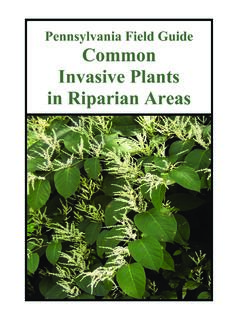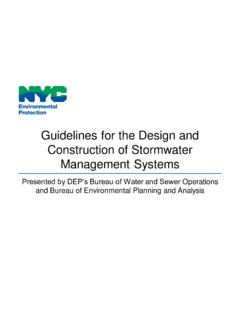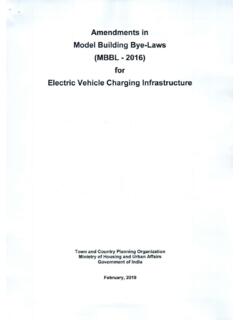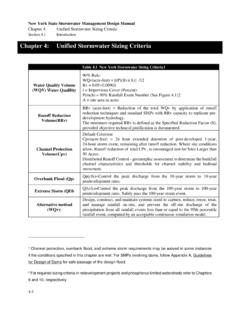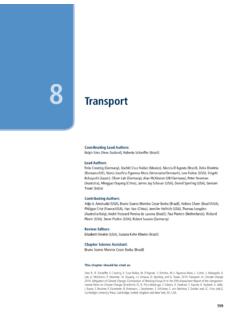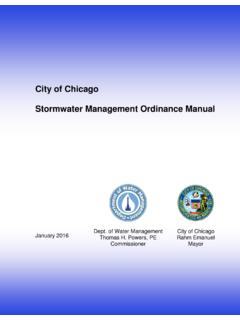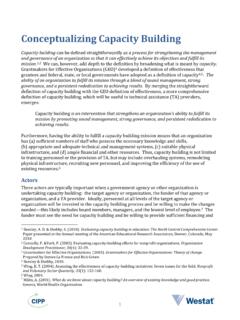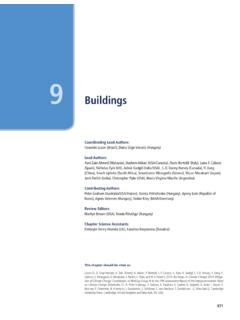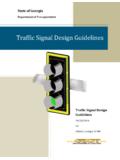Transcription of Pennsylvania Stormwater Best Management Practices …
1 Pennsylvania StormwaterBest Management PracticesManualDRAFT - JANUARY 2005 Section 6 Comprehensive Stormwater Management :Structural BMPsAnthony McQueen, page intentionally left Pennsylvania Stormwater Management ManualSection 6 - Structural BMPsSection 6 Comprehensive Stormwater Management : Structural of Structural Rate Reduction by Infiltration BMPsBMP Pavement with Infiltration BedBMP BasinBMP Infiltration BedBMP TrenchBMP Garden / BioretentionBMP Well / Seepage PitBMP FilterBMP SwaleBMP Filter StripBMP Berm & Retentive Rate Reduction BMPsBMP RoofBMP Runoff Capture & Quality/Peak Rate BMPsBMP WetlandBMP Pond / Retention BasinBMP Extended Detention BasinBMP Quality BMPsBMP Buffer RestorationBMP RestorationBMP Amendment & BMPs and Related Structural MeasuresBMP SpreaderBMP Detention Areas Parking Lot, for Structural BMPsProtocol 1.
2 Infiltration Systems GuidelinesProtocol 2. Soil Evaluation and Investigation for Infiltration BMPs6-198 Draft - Pennsylvania Stormwater Management ManualSection 6 - Structural Structural BMPs have been listed and described in this section of the manual. As indicatedin both Sections 4 and 5, many of these structures are natural system-based, including both vegetationand soils mechanisms as part of their functioning. In that sense, though classified as structural, they can and should be viewed as green structures or green infrastructure. More conventional bricks and mortar structures, of course, are also included in this 21 Structural BMPs may seem like an especially long list, the list could easily have grownmuch longer, if the many different variations of each BMP were included separately.
3 For example,Vegetated Swales have several different variations on the central theme; these variations have beenincluded in this section with some explanation and reference made as to how and when such variationscan be successfully applied. On the other hand, some of the Structural BMPs are quite similar toothers even to other Non-Structural BMPs ( , Protect/Conserve/Enhance Riparian Areasand Riparian Buffer Restoration), though it was ultimately decided that they merited separatetreatment. As long as the Structural List might be at the present time, even more BMPs can beexpected to emerge which is as it should BMP is outlined using approximately the same structure or outline as has been applied to theNon-Structural of Structural BMPsStructural BMPs can be grouped according to the primary, though not exclusive, Stormwater functions,as follows:Volume/Peak Rate Reduction by Infiltration BMPsVolume/Peak Rate Reduction BMPsRunoff Quality/Peak Rate BMPsRestoration BMPsOther BMPsIn all cases, these Stormwater functions are linked to the Recommended Site Control Guidelineswhich are presented in Table 3-4 in Section 3.
4 Because of the importance of Volume/Peak RateReduction, most of the Structural BMPs fall into this category, not surprisingly with many of theseBMPs being infiltration-oriented; these BMPs also happen to provide excellent water qualityperformance as well. Volume/Peak Rate functions also can be provided a smaller group of increasinglyimportant Structural BMPs such as Vegetated Roofs and Roof Capture/Reuse ( , rain barrels andcisterns). Certain BMPs provide water quality and peak rate control functions, without any significantcontrol of volume. The Restoration BMPs and Other BMP categories provide a mix of stormwaterfunctions, and although these BMPs have not been frequently used in the past, they can offer realpotential for many Pennsylvania municipalities in the , two special lists of instructions, or Protocols, have been developed specifically for use with allinfiltration-oriented structural BMPs:Protocol 1: Infiltration System GuidelinesProtocol 2: Soil Evaluation and Investigation for Infiltration BMPs6-199 Draft Pennsylvania Stormwater Management ManualSection 6 - Structural BMPsBoth of these Protocols follow the individual BMPs in this section.
5 These instructions should befollowed whenever infiltration-oriented BMPs are being developed. The Protocols set forth a varietyof actions which should be taken, which are common to all infiltration-oriented BMPs, in order tomake sure that proper site conditions and constraints are being adequately addressed, proper designconsiderations are being taken, and proper construction specifications are integrated into the overalldesign of the BMP. An especially important aspect of these instructions focuses on full and carefultesting of the soil, thereby necessitating a separate Protocol that addresses soil testing and analysisin great depth. If these Protocols are followed, the risk of failed infiltration-oriented BMPs will beminimized, if not of the most challenging technical issues considered in this Manual involves the selection ofBMP s that have a high degree of NPS reduction or removal efficiency.
6 In the ideal, a BMP should beselected that has a proven NPS pollutant removal efficiency for all pollutants of importance, especiallythose that are critical in a specific watershed (as defined by a TMDL or other process). Both Non-Structural BMP s in Section 5 and Structural BMP s in Section 6 are rated in terms of their pollutantremoval performance or effectiveness. The initial BMP selection process analyzes the final site planand estimates the potential NPS load, using Table 2-2 and Appendix A. The required reductionpercentage for representative pollutants (such as 85% reduction in TSS and TP load and 50% reductionin the solute load) is achieved by a suitable combination of Non-Structural and Structural BMP s.
7 Thisprocess is described in more detail in Section ProductsA variety of manufactured product suppliers, distributors, and manufacturers have provided extensiveproduct information to PADEP during the course of this manual preparation process. Information hasbeen provided thus far by:ACF Environmental, Hill CorporationClearwater Technologies, company, ACF Environmental, Inc., in particular has provided this information and taken thetime to organize its products to coordinate with the structure of this manual. Many of these productscan be used in conjunction with the Non-Structural BMPs set forth in Section 5 as well as the StructuralBMPs in Section 6. In many, if not most cases, proper application and use of these manufacturedproducts can further the Stormwater Management goals and objectives that are at the core of thismanual and the new PADEP program.
8 At the same time, it was decided that these products did notfit into the manual as either Non-Structural or Structural BMP generic types per se. It should be notedalso that Pennsylvania does not have a review and testing function established within state governmentat this point, as a few other states have developed, which provides for thorough testing and rating ofthese manufactured products. The interested reader/user is directed to other sources, such as:Environmental Technology Evaluation Center (EvTEC) of The Civil Engineering ResearchFoundation (CERF), including their Stormwater best Management Practices (BMPs) VerificationProgram - information available at & - Pennsylvania Stormwater Management ManualSection 6 - Structural EPA s Environmental Technology Verification Program (ETV) - information available University of New Hampshire s Center for Stormwater Technology Evaluation andVerification (CSTEV) - information available at #The Chesapeake Bay Program s Innovative Technology Task Force (ITTF)
9 - information aboutthe program as well as many useful links to other programs available at Jersey s Energy and Environmental Technology Verification Program - results availablethrough the New Jersey Corporation for Advanced Technology (NJCAT) at PADEP would like to develop an electronic bulletin board designed to array any and allsuch information in the future, simply as an information clearinghouse (with no evaluation function),this Manual is simply providing all of this information in an appendix, together with any/all guidanceand explanation provided by the respective providers. This information is caveated as follows:Disclaimer: The technology descriptions contained in this document including, but not limitedto, information on technology applications, performance, limitations, benefits, and cost, havebeen provided by vendors.
10 No attempt was made to examine, screen or verify company ortechnology information. The Pennsylvania Department of Environmental Protection has notconfirmed the accuracy or legal adequacy of any disclosures, product performance, or otherinformation provided by the companies appearing here. The inclusion of specific products inthis document does not constitute or imply their endorsement or recommendation by thePennsylvania Department of Environmental do consider using these products, as in many cases, the products can be quite cost effective andprovide an excellent headstart in the Stormwater Management planning process. Again, PADEP hopes to be able to provide more evaluative guidance on these manufactured in the future, asbudget Pennsylvania Stormwater Management ManualSection 6 - Structural Volume/Peak Rate Reduction by Infiltration BMPs6-202 Draft Pennsylvania Stormwater Management ManualSection 6 - Structural BMPs6-203 Draft Pennsylvania Stormwater Management ManualSection 6 - Structural BMPsVolume/Peak Rate Reduction by Infiltration BMPsBMP : Porous Pavement with Infiltration BedPorous pavement consists of apermeable surface courseunderlain by a uniformly-gradedstone bed which providesstormwater Management .



